
The Metropolitan Museum of Art in New York City, colloquially "the Met", is the largest art museum in the Americas. In 2022 it welcomed 3,208,832 visitors, ranking it the third most visited U.S museum, and eighth on the list of most-visited art museums in the world. Its permanent collection contains over two million works, divided among 17 curatorial departments. The main building at 1000 Fifth Avenue, along the Museum Mile on the eastern edge of Central Park on Manhattan's Upper East Side, is by area one of the world's largest art museums. The first portion of the approximately 2-million-square-foot (190,000 m2) building was built in 1880. A much smaller second location, The Cloisters at Fort Tryon Park in Upper Manhattan, contains an extensive collection of art, architecture, and artifacts from medieval Europe.

An art museum or art gallery is a building or space for the display of art, usually from the museum's own collection. It might be in public or private ownership, be accessible to all, or have restrictions in place. Although primarily concerned with visual art, art museums are often used as a venue for other cultural exchanges and artistic activities, such as lectures, jewelry, performance arts, music concerts, or poetry readings. Art museums also frequently host themed temporary exhibitions, which often include items on loan from other collections.

Brixton is a district in south London, part of the London Borough of Lambeth, England. The area is identified in the London Plan as one of 35 major centres in Greater London. Brixton experienced a rapid rise in population during the 19th century as communications with central London improved.

Wapping is a district in East London in the London Borough of Tower Hamlets. Wapping's position, on the north bank of the River Thames, has given it a strong maritime character, which it retains through its riverside public houses and steps, such as the Prospect of Whitby and Wapping Stairs. It also has a Royal Navy shore establishment base on the riverfront called HMS President and home to Tobacco Dock and King Edward Memorial Park.

Lambeth is a London borough in South London, England, which forms part of Inner London. Its name was recorded in 1062 as Lambehitha and in 1255 as Lambeth. The geographical centre of London is at Frazier Street near Lambeth North tube station, though nearby Charing Cross on the other side of the Thames in the City of Westminster is traditionally considered the centre of London.
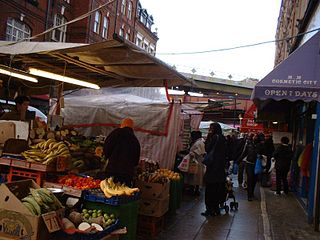
Brixton Market comprises a street market in the centre of Brixton, south London, and the adjacent covered market areas in nearby arcades Reliance Arcade, Market Row and Granville Arcade.

State Library Victoria (SLV) is the state library of Victoria, Australia. Located in Melbourne, it was established in 1854 as the Melbourne Public Library, making it Australia's oldest public library and one of the first free libraries in the world. It is also Australia's busiest library and, as of 2018, the world's fourth-most-visited library.
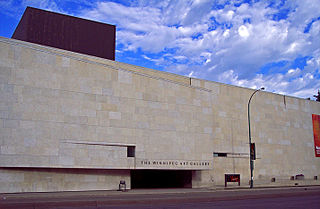
The Winnipeg Art Gallery (WAG) is an art museum in Winnipeg, Manitoba, Canada. Its permanent collection includes over 24,000 works from Canadian, Indigenous Canadian, and international artists. The museum also holds the world's largest collection of Inuit art. In addition to exhibits for its collection, the museum has organized and hosted a number of travelling arts exhibitions. Its building complex consists of a main building that includes 11,000 square metres (120,000 sq ft) of indoor space and the adjacent 3,700-square-metre (40,000 sq ft) Qaumajuq building.

The Australian Museum is a heritage-listed museum at 1 William Street, Sydney central business district, New South Wales, Australia. It is the oldest museum in Australia, and the fifth oldest natural history museum in the world, with an international reputation in the fields of natural history and anthropology. It was first conceived and developed along the contemporary European model of an encyclopedic warehouse of cultural and natural history and features collections of vertebrate and invertebrate zoology, as well as mineralogy, palaeontology and anthropology. Apart from exhibitions, the museum is also involved in Indigenous studies research and community programs. In the museum's early years, collecting was its main priority, and specimens were commonly traded with British and other European institutions. The scientific stature of the museum was established under the curatorship of Gerard Krefft, himself a published scientist.
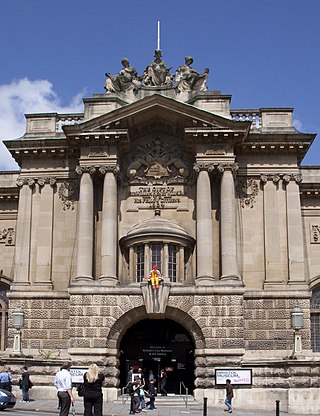
Bristol Museum & Art Gallery is a large museum and art gallery in Bristol, England. The museum is situated in Clifton, about 0.5 miles (0.8 km) from the city centre. As part of Bristol Culture it is run by the Bristol City Council with no entrance fee. It holds designated museum status, granted by the national government to protect outstanding museums. The designated collections include: geology, Eastern art, and Bristol's history, including English delftware. In January 2012 it became one of sixteen Arts Council England Major Partner Museums.

The Museum of the Home, formerly the Geffrye Museum, is a free museum in the 18th-century Grade I-listed former almshouses on Kingsland Road in Shoreditch, London. The museum's change of name was announced in 2019. The museum explores home and home life from 1600 to the present day with galleries which ask questions about 'home', present diverse lived experiences, and examine the psychological and emotional relationships people have with the idea of "home" alongside a series of period room displays.
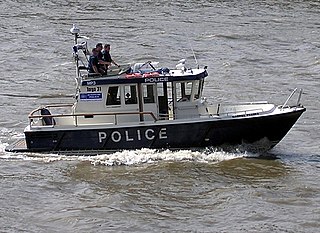
The Marine Policing Unit (MPU) is the waterborne policing unit of London's Metropolitan Police Service, forming part of the Met Taskforce (MO7) within Met Operations. Its 22 vessels are responsible for waterborne policing of the River Thames in Greater London and supporting the rest of the Metropolitan Police and to the City of London Police when dealing with incidents in or around any waterway in London. A specialist underwater and confined-spaces search team carries out searches throughout the Metropolitan Police District. The unit also has 24 officers who are trained in rope access techniques and trained to carry out searches and counter-demonstrator operations at height.
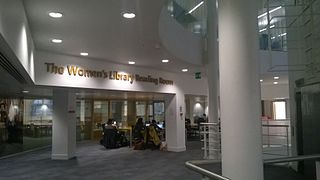
The Women's Library is England's main library and museum resource on women and the women's movement, concentrating on Britain in the 19th and 20th centuries. It has an institutional history as a coherent collection dating back to the mid-1920s, although its "core" collection dates from a library established by Ruth Cavendish Bentinck in 1909. Since 2013, the library has been in the custody of the London School of Economics and Political Science (LSE), which manages the collection as part of the British Library of Political and Economic Science in a dedicated area known as the Women's Library.

Doon Heritage Village, located at the Ken Seiling Waterloo Region Museum, is a picturesque 60 acre living history village that shows visitors what life was like in the Waterloo Region in the year 1914. It is located in the former Doon village, now part of Kitchener, Ontario, Canada, next to Homer Watson Park.

Ilkley Manor House, Ilkley, West Yorkshire, England, is a local heritage museum, art gallery, and live venue, and was established in the present building in 1961 to preserve local archaeological artefacts after the spa town expanded and much Roman material was lost. It was managed by Bradford Council Museums and Galleries department but had to be closed in 2013 owing to lack of funds. In order to keep the building open to the public, the Ilkley Manor House Trust was formed, and in April 2018, Bradford Council transferred the Manor House and three adjacent cottages to the Trust as a community asset transfer.
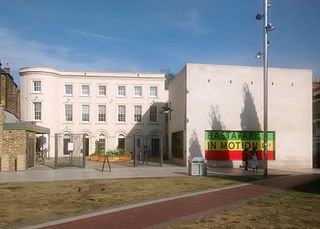
Black Cultural Archives (BCA) is an archive and heritage centre in Brixton, London, devoted to the histories of people of African and Caribbean descent in Britain. Also known as BCA, it was founded in 1981, by educationalist and historian Len Garrison and others. BCA's mission is to record, preserve and celebrate the history of people of African descent in Britain. The BCA's new building in Brixton, opened in 2014, enables access to the archive collection, provides dedicated learning spaces and mounts a programme of exhibitions and events.
Ajamu X is a British artist, curator, archivist and activist. He is best known for his fine art photography which explores same-sex desire, and the Black male body, and his work as an archivist and activist to document the lives and experiences of black LGBTQ people in the United Kingdom (UK).

The Justice and Police Museum is a heritage-listed former water police station, offices and courthouse and now justice and police museum located at 4-8 Phillip Street on the corner of Albert Street, in the Sydney central business district in the City of Sydney local government area of New South Wales, Australia. It was designed by Edmund Blacket, Alexander Dawson and James Barnet and built from 1854 to 1886. It is also known as Police Station & Law Courts (former) and Traffic Court. The property is owned by the Department of Justice, a department of the Government of New South Wales. It was added to the New South Wales State Heritage Register on 2 April 1999.

John Dixon Butler was a British architect and surveyor who had a long, professional association with London's Metropolitan Police. During his 25-year career with the police, he completed the designs and alterations to around 200 police buildings, including ten courts; as of 2022, about 58 of his buildings survive. Historic England describes him as "one of the most accomplished Metropolitan Police architects" and have included around 25 of his buildings on the National Historic List of England and Wales.

The Bow Street Police Museum, opened in 2021, is based in the former police station in Covent Garden, London. Bow Street has a unique place in the history of policing in London, with the museum presenting the story of policing and criminal justice in the area from the eighteenth century until 1992, when the police station closed.




















